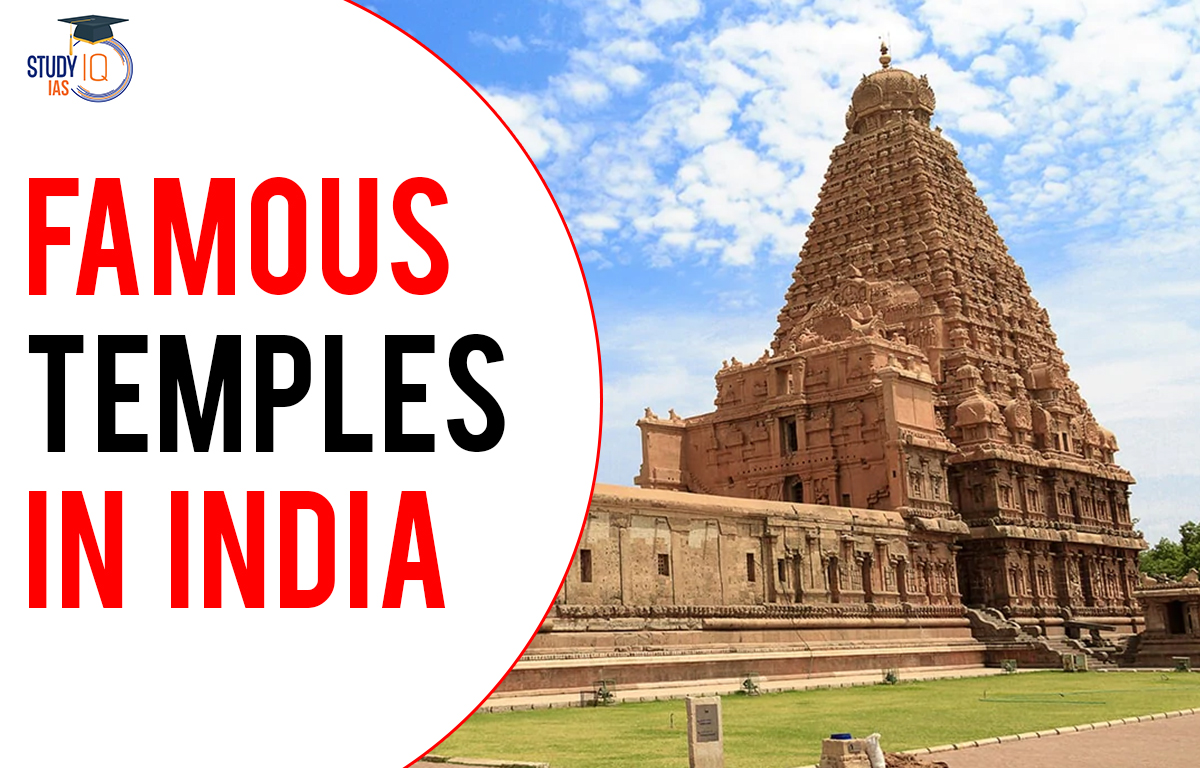India’s rich tapestry of spirituality and culture is vividly reflected in its numerous temples, each representing a unique blend of architectural brilliance and religious significance. For UPSC aspirants, understanding these temples is essential, as questions related to them often appear in General Studies papers, especially in the context of Indian culture and history.
Famous Temples in India
India is a land of diverse religions and cultures, with Hinduism, Jainism, Buddhism, and Sikhism being among the prominent ones. Temples in India are not only places of worship but also symbols of artistic excellence and historical narratives. Through different historical periods, they offer insights into the region’s religious practices, societal values, and architectural styles.
List of Famous Temples in India
Here’s a complete List of All Famous Temples in India in 2024
| Temple Name |
Location |
| Kedarnath Temple |
Rudraprayag, Uttarakhand |
| Somnath Temple |
Somnath Gujarat |
| Vaishno Devi Temple |
Katra, Jammu and Kashmir |
| Ramanathaswamy Temple |
Rameshwaram, Tamil Nadu |
| Kashi Vishwanath Temple |
Varanasi, Uttar Pradesh |
| Konarak Sun Temple |
Konark, Odisha |
| Shri Jagannath Temple |
Puri, Odisha |
| Yamunotri Temple |
Uttarkashi, Uttarakhand |
| Meenakshi Temple |
Madurai, Tamil Nadu |
| Amarnath Cave Temple |
Jammu and Kashmir |
| Lingaraja Temple |
Bhubaneswar, Odisha |
| Tirupati Balaji Temple |
Tirumala, Andhra Pradesh |
| Kanchipuram Temples |
Kanchipuram, Tamil Nadu |
| Ranakpur Temple |
Pali, Rajasthan |
| Shirdi Sai Baba Temple |
Shirdi, Maharashtra |
| Shri Padmanabhaswamy Temple |
Trivandrum, Kerala |
| Dwarkadhish Temple |
Dwarka, Gujarat |
| Laxminarayan Temple |
Delhi |
| Siddhivinayak Temple |
Mumbai, Maharashtra |
| Gangotri Temple |
Uttarkashi, Uttarakhand |
| Iskcon Temple |
Vrindavan, Uttar Pradesh |
| Mahabodhi Temple |
Gaya, Bihar |
| Kamakhya Temple |
Guwahati, Assam |
| Khajuraho Temple |
Khajuraho, Madhya Pradesh |
| Virupaksha Temple |
Hampi, Karnataka |
| Akshardham Temple |
Delhi |
| Shri Digambar Jain Lal Mandir |
Delhi |
| Sanchi Stupa |
Sanchi, Madhya Pradesh |
| Golden Temple |
Amritsar, Punjab |
1. Kedarnath Temple
- Location: Kedarnath, Rudraprayag district, Uttarakhand
- Significance: Dedicated to Lord Shiva, the Kedarnath Temple is one of the twelve Jyotirlingas and a key site in the Char Dham pilgrimage. Perched at an altitude of 3,580 meters, it is revered for its association with the Pandavas from the Mahabharata.
- Historical Context: The temple is believed to have been originally built by the Pandavas and later reconstructed by Adi Shankaracharya. It is accessible only during the summer months due to heavy snowfall in the region.
2. Somnath Temple
- Location: Somnath, Saurashtra, Gujarat
- Significance: This temple is one of the twelve Jyotirlingas dedicated to Lord Shiva. It is located on the western coast of India, and its legend is mentioned in the Rigveda and the Shivpuran.
- Historical Context: The temple has been rebuilt several times due to invasions, with the current structure built by Sardar Vallabhbhai Patel in 1951. It symbolizes resilience and devotion in Hindu tradition.
3. Vaishno Devi Temple
- Location: Katra, Reasi district, Jammu & Kashmir
- Significance: Dedicated to Goddess Vaishno Devi, this temple is one of the most visited pilgrimage sites in India. Situated at an altitude of 5,200 feet, it attracts millions of devotees annually.
- Historical Context: The temple’s origins are steeped in Hindu mythology, and it is believed that the goddess chose this location to escape from the demon king Bhairon.
4. Ramanathaswamy Temple
- Location: Rameswaram, Ramanathapuram district, Tamil Nadu
- Significance: One of the twelve Jyotirlingas, this temple is renowned for its extensive corridor, the longest in India. It is dedicated to Lord Shiva and plays a vital role in the Ramayana epic.
- Historical Context: The temple was originally constructed by the Chola dynasty, with significant additions and renovations over the centuries.
5. Kashi Vishwanath Temple
- Location: Varanasi, Uttar Pradesh
- Significance: Dedicated to Lord Shiva, Kashi Vishwanath is one of the twelve Jyotirlingas and is considered one of the holiest temples in Hinduism. It is located on the banks of the Ganges River.
- Historical Context: The temple has a long history, having been destroyed and rebuilt several times. The current structure was constructed by the Maratha ruler Ahilyabai Holkar in the 18th century.
6. Konark Sun Temple
- Location: Konark, Odisha
- Significance: This temple is dedicated to the Sun God, Surya, and is renowned for its chariot-like structure with intricately carved wheels, horses, and deities.
- Historical Context: Built in the 13th century by King Narasimhadeva I of the Eastern Ganga Dynasty, it is a UNESCO World Heritage Site and an example of medieval Kalinga architecture.
7. Shri Jagannath Temple
- Location: Puri, Odisha
- Significance: The temple is dedicated to Lord Jagannath, a form of Lord Krishna, and is famous for its annual Ratha Yatra (chariot festival), where the deities are paraded through the streets of Puri.
- Historical Context: The temple dates back to the 12th century and has been a significant site in the Char Dham pilgrimage circuit.
8. Yamunotri Temple
- Location: Yamunotri, Uttarkashi district, Uttarakhand
- Significance: Dedicated to Goddess Yamuna, this temple is the starting point of the Char Dham pilgrimage. It is located near the source of the Yamuna River.
- Historical Context: The temple is one of the four sacred shrines in the Char Dham Yatra and is associated with several legends and rituals.
9. Meenakshi Temple
- Location: Madurai, Tamil Nadu
- Significance: Dedicated to Goddess Meenakshi (a form of Parvati) and Lord Sundareswarar (a form of Shiva), the temple is famous for its stunning Dravidian architecture and extensive sculptures.
- Historical Context: The temple was expanded and renovated by various dynasties, including the Pandyas and the Nayaks, over several centuries.
10. Amarnath Cave Temple
- Location: Anantnag district, Jammu & Kashmir
- Significance: Known for the naturally occurring Shiva Lingam, this cave temple is a significant site for the Amarnath Yatra pilgrimage. It is located at an altitude of 3,888 meters.
- Historical Context: The cave is covered in snow for most of the year and is accessible only during the summer months. It is associated with various legends and religious texts.
11. Sree Padmanabhaswamy Temple
- Location: Thiruvananthapuram, Kerala
- Significance: Dedicated to Lord Vishnu, this temple is renowned for its opulent architecture and significant treasures. It is one of the 108 Divya Desams, important Vaishnavite pilgrimage sites.
- Historical Context: The temple has ancient roots and has been an important site for Vaishnavism, with its current structure being built in the 18th century.
12. Dwarkadhish Temple
- Location: Dwarka, Gujarat
- Significance: Dedicated to Lord Krishna, this temple is a crucial site in the Char Dham pilgrimage and is revered as the “King of Dwarka.”
- Historical Context: Believed to have been established over 2,200 years ago, the temple features Chalukya-style architecture and is an important site in Krishna’s lore.
13. Lingaraja Temple
- Location: Bhubaneswar, Odisha
- Significance: Dedicated to Lord Shiva, this temple is an exemplary example of Kalinga architecture and is a significant site in the city of Bhubaneswar.
- Historical Context: Built in the 11th century during the reign of the Somavamsa dynasty, the temple is noted for its large size and elaborate carvings.
14. Khajuraho Temples
- Location: Khajuraho, Madhya Pradesh
- Significance: Known for their exquisite carvings and erotic sculptures, these temples represent the zenith of Chandela architecture and are UNESCO World Heritage Sites.
- Historical Context: Built between 950 and 1050 AD, the temples reflect the architectural and artistic achievements of the Chandela dynasty.
15. Virupaksha Temple
- Location: Hampi, Karnataka
- Significance: Dedicated to Lord Shiva, this temple is part of the UNESCO World Heritage Site of Hampi and is known for its grand architecture and historical importance.
- Historical Context: The temple was constructed during the Vijayanagara Empire and has been a major pilgrimage site for centuries.
16. Akshardham Temple
- Location: Delhi
- Significance: Dedicated to Bhagwan Swaminarayan, this modern temple showcases Indian art, culture, and architecture through its elaborate exhibitions and architecture.
- Historical Context: Completed in 2005, it has quickly become a major cultural and spiritual landmark in Delhi.
17. Laxminarayan Temple
- Location: Delhi
- Significance: Also known as the Birla Mandir, this temple is dedicated to Lord Vishnu (Laxminarayan) and is known for its modern architectural style.
- Historical Context: Built in the early 20th century by the Birla family, it is one of the most prominent temples in Delhi.
18. Siddhivinayak Temple
- Location: Mumbai, Maharashtra
- Significance: Dedicated to Lord Ganesha, this temple is one of the most visited and revered in Mumbai, attracting celebrities and devotees alike.
- Historical Context: Established in 1801, the temple has gained immense popularity over the years for its role in removing obstacles and granting wishes.
19. Gangotri Temple
- Location: Gangotri, Uttarkashi district, Uttarakhand
- Significance: Dedicated to Goddess Ganga, this temple is the starting point of the Char Dham Yatra and is situated near the source of the Ganges River.
- Historical Context: The temple is a significant site for worship and pilgrimage, especially for devotees of the Ganga.
20. Iskcon Temple
- Location: Vrindavan, Uttar Pradesh
- Significance: Also known as the Krishna-Balaram Mandir, it is dedicated to Lord Krishna and Balarama and is a major center for the
Top 10 Famous Temples in India
| Temple Name |
Location |
Significance |
Historical Context |
| Somnath Temple |
Somnath, Gujarat |
One of the twelve Jyotirlingas dedicated to Lord Shiva. |
The temple has been destroyed and rebuilt several times, with the current structure reconstructed in 1951 by Sardar Vallabhbhai Patel. It symbolizes the resilience and devotion of the Hindu community. |
| Shri Kashi Vishwanath Temple |
Varanasi, Uttar Pradesh |
Dedicated to Lord Shiva, one of the twelve Jyotirlingas, located on the banks of the Ganges River. |
The temple has faced destruction and reconstruction throughout history, most notably by Aurangzeb. The current structure was rebuilt in the 18th century by Ahilyabai Holkar of Indore, reflecting its enduring significance. |
| Tirupati Balaji Temple |
Tirumala, Andhra Pradesh |
Known as Sri Venkateswara Swami Vaari Temple, dedicated to Lord Vishnu, a major pilgrimage site. |
The temple’s origins are ancient, with Lord Vishnu believed to have descended to earth. It is renowned for its annual Brahmotsavam festival and the significant offerings made by devotees. |
| Sree Padmanabhaswamy Temple |
Thiruvananthapuram, Kerala |
Dedicated to Lord Vishnu, it is one of the 108 Divya Desams, significant in Vaishnavism. |
The temple is considered to have ancient origins and is associated with the royal family of Travancore. Its architectural splendor and treasures make it a prominent site in Vaishnavite worship. |
| Shri Jagannath Temple |
Puri, Odisha |
Dedicated to Lord Jagannath, a form of Lord Krishna, known for the annual Ratha Yatra festival. |
The temple is part of the Char Dham pilgrimage and dates back to the 12th century. The Ratha Yatra, where the deities are paraded on large chariots, is a major event drawing millions of devotees. |
| Amarnath Cave Temple |
Anantnag, Jammu & Kashmir |
Dedicated to Lord Shiva, features a naturally occurring Shiva Lingam formed by ice. |
The cave temple is accessible only during the summer months due to heavy snow. It holds significant mythological importance and is surrounded by stunning snow-capped peaks and glaciers. |
| Kedarnath Temple |
Kedarnath, Uttarakhand |
One of the twelve Jyotirlingas dedicated to Lord Shiva, located at a high altitude. |
The temple is mentioned in the Skanda Purana and is a crucial part of the Char Dham pilgrimage. It is accessible only in the summer months due to its remote and snowy location. |
| Badrinath Temple |
Badrinath, Uttarakhand |
Dedicated to Lord Vishnu, a key site in the Char Dham Yatra. |
The temple’s origins are linked to Adi Shankaracharya, who is said to have discovered the deity’s idol. It remains a vital site for devotees seeking spiritual blessings and is a central attraction in the town of Badrinath. |
| Gangotri Temple |
Gangotri, Uttarkashi, Uttarakhand |
Dedicated to Goddess Ganga, it is the temple where the Ganges River is honored. |
The temple is located near the source of the Ganges River, known as Bhagirathi. It is an essential site for pilgrimage and religious ceremonies, built to honor the sacred river. |
| Konark Sun Temple |
Konark, Odisha |
Dedicated to the Sun God Surya, renowned for its architectural grandeur resembling a chariot. |
Built in the 13th century by King Narasimhadeva I, the temple is a UNESCO World Heritage Site and a masterpiece of Kalinga architecture. Its intricate carvings and chariot-like structure highlight the artistic achievements of the time. |
Famous Temples of India UPSC
For UPSC aspirants, understanding the historical, cultural, and architectural significance of these temples can provide a deeper insight into India’s diverse heritage. These temples are not just religious centers but also serve as important markers of India’s historical evolution, artistic achievements, and societal values. Their study can offer valuable context for questions related to Indian culture, history, and architecture in the UPSC exams.
Sharing is caring!


 Miss Universe Winners List From 1952 to ...
Miss Universe Winners List From 1952 to ...
 CGPSC Result (Final) 2025 Out: Download ...
CGPSC Result (Final) 2025 Out: Download ...
 RUDRA Brigade: The Biggest Transformatio...
RUDRA Brigade: The Biggest Transformatio...

























